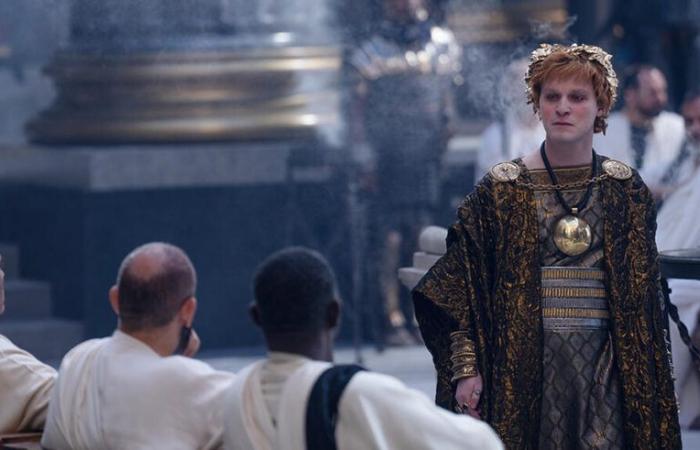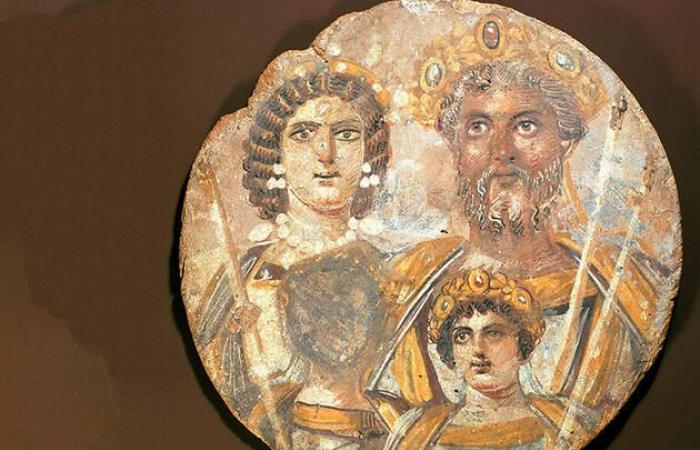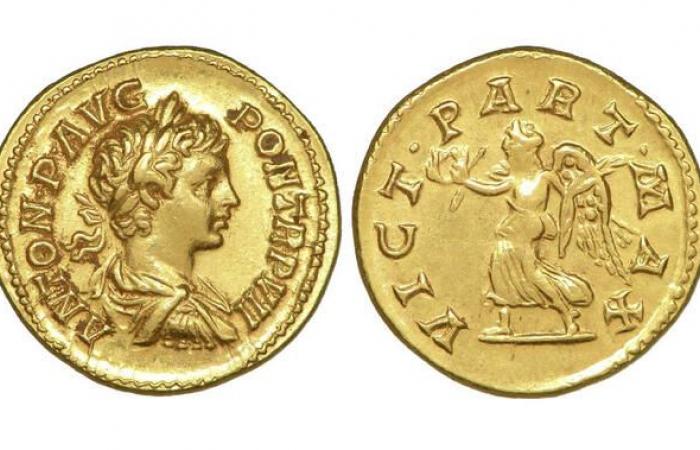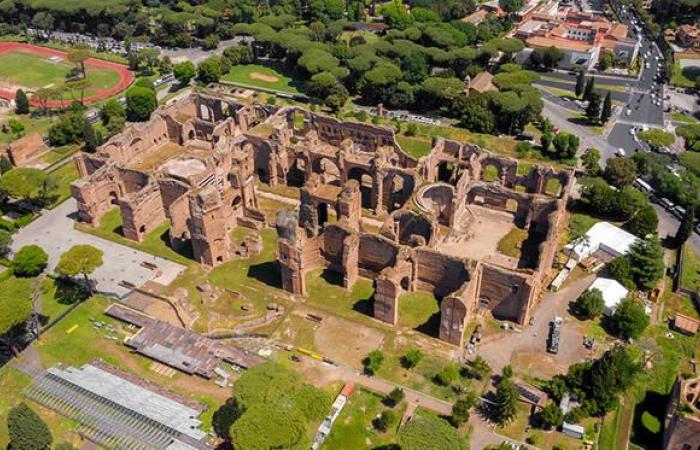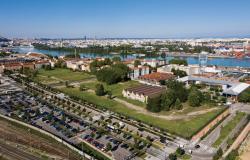After Commodus in “Gladiator”, Caracalla appears as the new crazy and cruel Roman emperor in this second opus which is released in theaters this week. A very dark image of the man who reigned from 211 to 217, whose current research strives to rehabilitate the political and military work as explained by the historian François Chausson.
Almost a quarter of a century later Gladiatordirector Ridley Scott returns to Roman Antiquity with a sequel to his famous epic. In what historical context do the events of Gladiator II ? and who is Caracalla, the emperor antagonist of the hero Lucius?
François Chausson. While Gladiator was located at the end of the Antonine era, under the reign of Emperor Commodus (181-192), Gladiator 2 takes place under another dynasty: the Severians (193-235). Septimius Severus, the founder of the dynasty that bears his name, took power after four years of civil wars following the assassination of Commodus. His eldest son was born around 186-188 in Lyon, where Septimius Severus was legate of the province of Lyon Gaul. The young Marcus Aurelius Antoninus took the names of Antoninus and Marcus Aurelius, two emperors of the previous dynasty, to whom his father attached himself to legitimize his new power. If, on the side of his father, born in Lepcis Magna in present-day Libya, the future Caracalla has African roots, on the side of his mother, Julia Domna, he descends from a line of Syrian princes of Greek culture, dynasts of the city of Emesa, today Homs.
Bust of Caracalla (188 – 217 AD), preserved in the Louvre. Official portrait distributed throughout the Roman Empire.
Photo Josse / Bridgeman Images
His father associated him with power from his childhood, giving him the title of Caesar at 8 or 10 years old and that of Augustus at 11 years old. Having come to power in 211 after the death of his father in York, the young man reigned until his assassination on April 8, 217 not far from Edessa, in the eastern part of the empire, by his praetorian prefect, the jurist and Roman knight Macrinus. He takes his nickname from caracallusa coat that he distributed to the crowd – these days, it's like calling it a “Parka”, “Anorak” or “Down Jacket”!
Just like Commode in the first opus, Caracalla is portrayed as a tyrannical and mad emperor. Where does his dark legend come from? How do historians view the character today?
F. C. His legend is less dark than that of other emperors, such as Caligula, Domitian, Commodus or Heliogabalus a few years after Caracalla. It is mainly the work of Cassius Dion, a contemporary Greek senator of Caracalla and author of a Roman historyin which he reports his conversations with the emperor whom he hardly liked. He criticizes him in particular for having wasted his good education to spend time with his soldiers. He himself does not nickname him “Caracalla”, a name fixed around 400 by theHistory Augustusbut “Tarautas”, named after a gladiator who looked like Caracalla.
Caracalla's edict in 212 allowed millions of free men throughout the empire to gain Roman citizenship.
The murder of his younger brother Geta, described by Cassius Dio as adorned with all virtues, as gentle as his father, particularly blackened Caracalla's reputation. However, it is quite pernicious to rely solely on literary sources, which like to classify emperors as good and bad. Today, research values his administrative and military work, with some notable successes on the borders of the Danube and the Euphrates along which he spent most of his short reign.
Caracalla appears today as a depressed and sick emperor. Very pious, he went from sanctuaries to sanctuaries – like Apollo Grannus in Gaul or Asclepius in Pergamum – in search of healing from who knows what illness. Likewise, its coinage and its iconography are analyzed as testimonies of the ideology of his reign.
In fact, for his contemporaries, his legend should not have been so dark, because it was by claiming his memory that his Syrian successors orchestrated the restoration of the Severians against Macrinus. One after the other, his two first cousins on his mother's side, Julia Soæmias and Julia Mamæa, said that they had given birth to the emperors Marcus Aurelius Antoninus (Heliogabalus) and Marcus Aurelius Alexander Severus (Severe Alexander), respectively, from his works. successors of his assassin.
Let's come to Geta's murder. How to explain this fratricide?
F. C. This is a great scene, worthy of an ancient tragedy. After the death of their father, the two brothers lived together for a year before the elimination of Geta by the very hand of Caracalla in the arms of his mother, stained with the blood of her son and injured in the hand by a blow from a sword. Caracalla kept the murder weapon at least until 216, when, during a stay in Alexandria four years after the events, he dedicated it to the god Serapis. To justify himself, Caracalla always claimed that his brother had plotted against him: why not believe him? That Geta was killed in this fight to the death is no guarantee of innocence. Indeed, the protocol inferiority from which the cadet suffered could have fueled bitterness for years. The two brothers did not benefit from the same preferential treatment from their father: while Caracalla was named Augustus at the age of eleven, Geta had to wait until twenty, in January 209.
Portrait of the family of Septimius Severus, circa 200 AD Emperor Septimus Severus (193-211 AD) is shown with his wife Julia Domna and sons Caracalla and Geta. The latter's face was erased after his assassination by Caracalla, his brother condemning him to oblivion (“damnatio memoriae”).
The elimination of Geta continues with purges, targeting senatorial members of the African branch of the dynasty as well as a daughter of Marcus Aurelius, and by a condemnation of his memory – a damnation of memory – without parallel in Roman history: inscriptions mentioning Geta are hammered, his name erased from coins and papyri, statues bearing his effigy destroyed, etc. Despite all these measures, Caracalla still complained during the rest of his reign that his brother appeared to him in visions, during nightmares. This is his Macbeth side: sources describe him as a worried, tormented character.
Caracalla is also known for the edict that bears his name. In 212, the emperor made every free man a Roman citizen. What does this edict change from the previous situation? and how can we explain this gesture on the part of a man accused of being a tyrant?
F. C. For a long time, since the Iis century BC BC, the Roman Empire had worked to spread Roman citizenship in the West and among the elites. However, at the beginning of IIIe century, peregrines, that is to say citizens enjoying the rights of their city but not Roman citizenship, remained the majority of the empire. The edict of Caracalla therefore had an unprecedented scale by allowing millions of men facilities in terms of actions within the army, commerce, marriages and integration into the higher orders of the Company. The social and political effects can be seen in the number of new citizens who, from 212, took the name “Marcus Aurelius”, after the emperor.
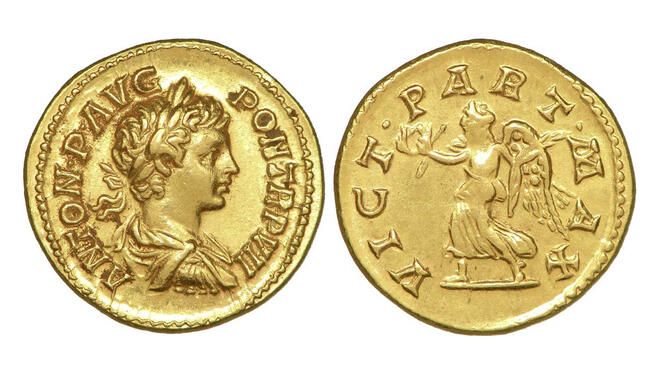
Aureus with the effigy of Caracalla (left, front side) and figure of victory holding a crown in his hand (right). Dated 204 AD. AD
cgb — http://www.cgb.fr/caracalla-aureus,v53_0375,a.html
Caracalla's motivations are multiple. Pious, he himself claims to have wanted to thank the gods of the Roman state who saved him from danger and gave him a victory by creating new Roman citizens capable of honoring them. Smirking, Cassius Dion mocks a fiscal motivation aimed at increasing revenue from a tax on inheritances paid by Roman citizens, the amount of which the emperor had just doubled, intended for the military treasury. Whatever the motivations, Caracalla's edict, a revolutionary measure within a centuries-old process, contributed to the normalization of provincial civic communities.
The emperor also left a legacy of the thermal baths which still bear his name today, among the most important archaeological remains of ancient Rome. Could you introduce them to us? Who were they intended for?
F. C. The baths of Caracalla, or Antoninian baths, are part of these large baths with a centered plan which developed from those of Nero on the Field of Mars, such as the baths of Titus, Trajan, Severus Alexander, then, later, of Diocletian and Constantine. Those of Caracalla were located at the mouth of the Via Appia, towards the exit of the city, not far from the Palatine. L'History Augustus reports that the vaults had metal frames. In fact, metal beams were found there during the Renaissance which confirm the existence of a kind of reinforced concrete. The decoration was sumptuous as evidenced by the basins and other statuary groups which came from it. Like all large public baths, it was intended for the plebs of Rome who went there in the evening.
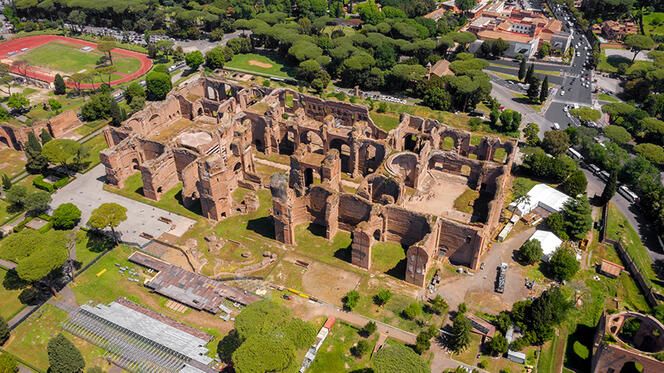
Aerial view of the Baths of Caracalla, inaugurated in Rome in 216 AD. AD
Stefano Tammaro /Stock.adobe.com
As a historian of Roman Antiquity, how do you view a peplum like Gladiator 2 ?
F. C. The specialist must maintain a calm, even benevolent position vis-à-vis major Hollywood productions. The goal is not to play the game of seven mistakes. On the contrary, it is a very good thing that Hollywood is interested in Antiquity. From this point of view, Gladiator revived the peplum film genre, which had been at a standstill since the 1950s and the golden age of Cinecittà. Very good historical films followed the first part, for example Alexander the Great (Oliver Stone, 2004) or even Now (Alejandro Amenábar, 2009).
The specialist must maintain a calm positioning vis-à-vis major Hollywood productions. The goal is not to play the game of seven mistakes.
However, we can consider that Gladiator lacked imagination. Remake of The Fall of the Roman Empire (Anthony Mann, 1964) – which despite a dream cast (Sophia Loren, Alec Guiness, James Mason, Omar Sharif, Christopher Plummer, etc.) generated a commercial failure and a financial abyss – the blockbuster by Ridley Scott accumulated gross errors on gladiature and clichés about Rome, dominated by violence, blood and sex. It is reasonable to think that Gladiator is above all an excellent comedy film!
More broadly, both Gladiator place their reading grid of Roman Antiquity under the sign of decadence, of the fall of the Roman Empire, a conception dating back to the 18the century andHistory of the decadence and fall of the Roman Empire by the British historian Edward Gibbon. However, we must question this notion of decadence: the Roman Empire did not fall but changed throughout Late Antiquity with a dislocation of its western territories in the 5the century. It would have been beneficial if Hollywood had gotten rid of these outdated commonplaces. ♦
To have
Gladiator II, by Ridley Scott, in theaters on Wednesday November 13, 2024.

